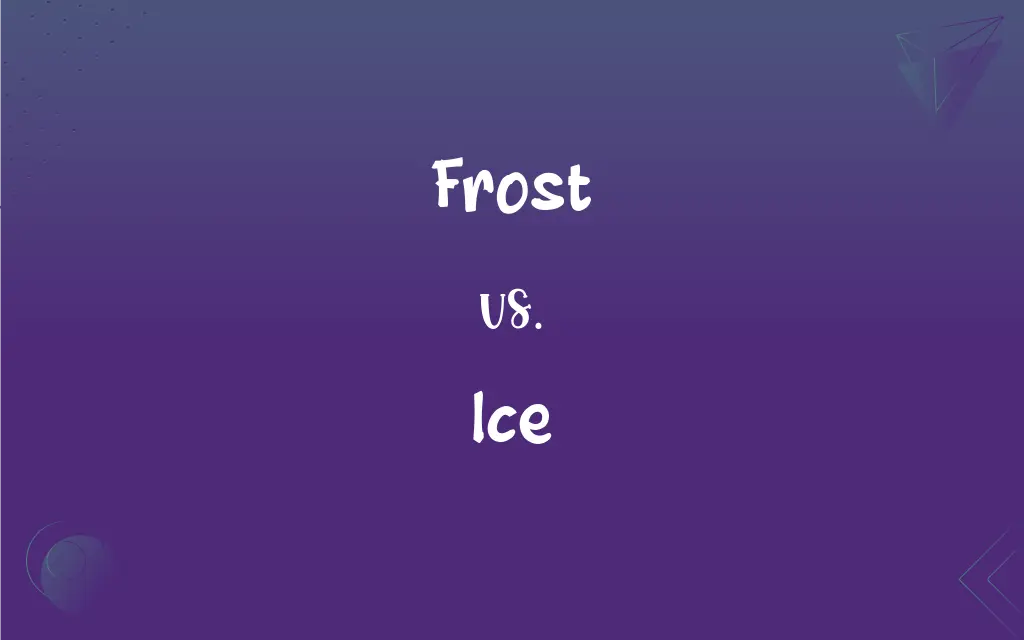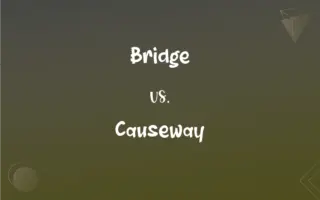Frost vs. Ice: What's the Difference?
Edited by Aimie Carlson || By Harlon Moss || Updated on November 7, 2023
Frost is the thin layer of ice crystals formed from atmospheric moisture on a surface when the temperature drops below freezing, while ice is water frozen into a solid state, often seen in larger bodies like ice cubes or glaciers.

Key Differences
Frost forms when water vapor changes from gas to solid, depositing as tiny crystals on surfaces, typically seen on grass or windows when temperatures are just below freezing. Ice is the solid form of water created when liquid water freezes, forming a hard, transparent substance seen in larger amounts than frost.
The formation of frost is a delicate process that occurs under specific conditions of humidity and temperature, resulting in a thin, feathery layer. Ice forms when temperatures are cold enough to change water's state, and it can accumulate to significant thickness on various surfaces or as bodies of frozen water.
Frost typically appears as a white, fuzzy layer and does not require a body of water to form, instead forming directly from water vapor. Ice, however, starts as liquid water and requires a drop in temperature to freeze into clear, solid forms, from thin glazes to deep ice sheets.
The occurrence of frost is often used as an indicator of a light freeze and can affect plants and crops, while the presence of ice is indicative of more severe cold and can pose a hazard in environments such as roads and bodies of water.
While both frost and ice can form in similar temperatures, frost is more likely to form on clear, cold nights with minimal wind, as it requires a delicate balance of conditions, while ice can form in a variety of cold conditions, especially when there is standing water or precipitation.
ADVERTISEMENT
Comparison Chart
Composition
Fine ice crystals.
Solidified water.
Formation Process
Sublimation of water vapor in the air.
Freezing of liquid water.
Appearance
Delicate, feathery, or spiky layer.
Hard, clear, and solid.
Temperature
Forms at temperatures just below freezing.
Can form at various subfreezing temperatures.
Impact
Affects plants, indicative of a light freeze.
Can be hazardous, indicative of severe cold.
ADVERTISEMENT
Frost and Ice Definitions
Frost
Cold weather that causes freezing.
The farmer worried about the late spring frost.
Ice
To cool with ice.
She iced her drink on a hot day.
Frost
A covering of minute ice crystals on cold surfaces.
The morning frost covered the lawn in a white blanket.
Ice
An icy or unfriendly manner.
He met her request with an ice-cold refusal.
Frost
To cover with a frost-like surface.
She frosted the cake with white icing to look like snow.
Ice
Diamonds or crystal decorations.
The celebrity wore ice around her neck at the gala.
Frost
An instance of freezing.
A frost tonight will mean trouble for the gardeners.
Ice
To make certain of success.
Scoring the last goal, he iced the game for his team.
Frost
A cold and frosty appearance.
His glasses had a frost after he came in from the cold.
Ice
Water frozen solid.
Frost
A deposit of minute ice crystals formed when water vapor condenses at a temperature below freezing.
Ice
A surface, layer, or mass of frozen water.
Frost
A period of weather when such deposits form.
FAQs
Is frost harmful to humans?
Frost itself isn't harmful to touch, but cold conditions can be.
Does frost damage plants?
Yes, frost can damage or kill plants by freezing the water inside them.
How thick can ice get?
Ice can range from a thin glaze to several feet thick in glaciers.
What causes frost to form on windows?
Frost forms on windows when moisture in the air contacts the cold glass.
Is ice always clear?
No, ice can appear opaque or cloudy due to trapped air or impurities.
Why does frost look feathery?
The patterns are due to the unique crystal structure of ice as it forms.
Can you see frost in the freezer?
Yes, frost can accumulate in freezers due to moisture in the air.
Can ice only form on water?
No, ice can form on any surface that's at freezing temperature.
Can frost form indoors?
Yes, if the indoor surface is cold enough and there's moisture in the air.
Can ice form without frost first appearing?
Yes, ice can form from liquid water even if frost hasn't appeared.
Is frost considered precipitation?
No, frost forms from water vapor, not from falling water droplets.
Is walking on ice safe?
It depends on the ice's thickness and strength; it can be very dangerous.
How can you prevent ice on sidewalks?
Using salt or sand can help melt ice or provide traction.
Is frost always white?
Frost is typically white due to the reflection of light off the ice crystals.
Does ice float on water?
Yes, because it is less dense than liquid water.
What is black ice?
Black ice is a thin, nearly invisible layer of ice on roads or sidewalks.
How quickly can ice form?
Ice can form quickly, especially if the water is already near freezing.
Can frostbite occur from frost?
Frostbite is more likely from prolonged exposure to cold, which can include ice and frost.
Why does ice form on the top of water?
Water is most dense at 4°C, so colder, less dense water rises and freezes.
What weather conditions create frost?
Clear skies, calm winds, and cold temperatures are ideal for frost formation.
About Author
Written by
Harlon MossHarlon is a seasoned quality moderator and accomplished content writer for Difference Wiki. An alumnus of the prestigious University of California, he earned his degree in Computer Science. Leveraging his academic background, Harlon brings a meticulous and informed perspective to his work, ensuring content accuracy and excellence.
Edited by
Aimie CarlsonAimie Carlson, holding a master's degree in English literature, is a fervent English language enthusiast. She lends her writing talents to Difference Wiki, a prominent website that specializes in comparisons, offering readers insightful analyses that both captivate and inform.































































